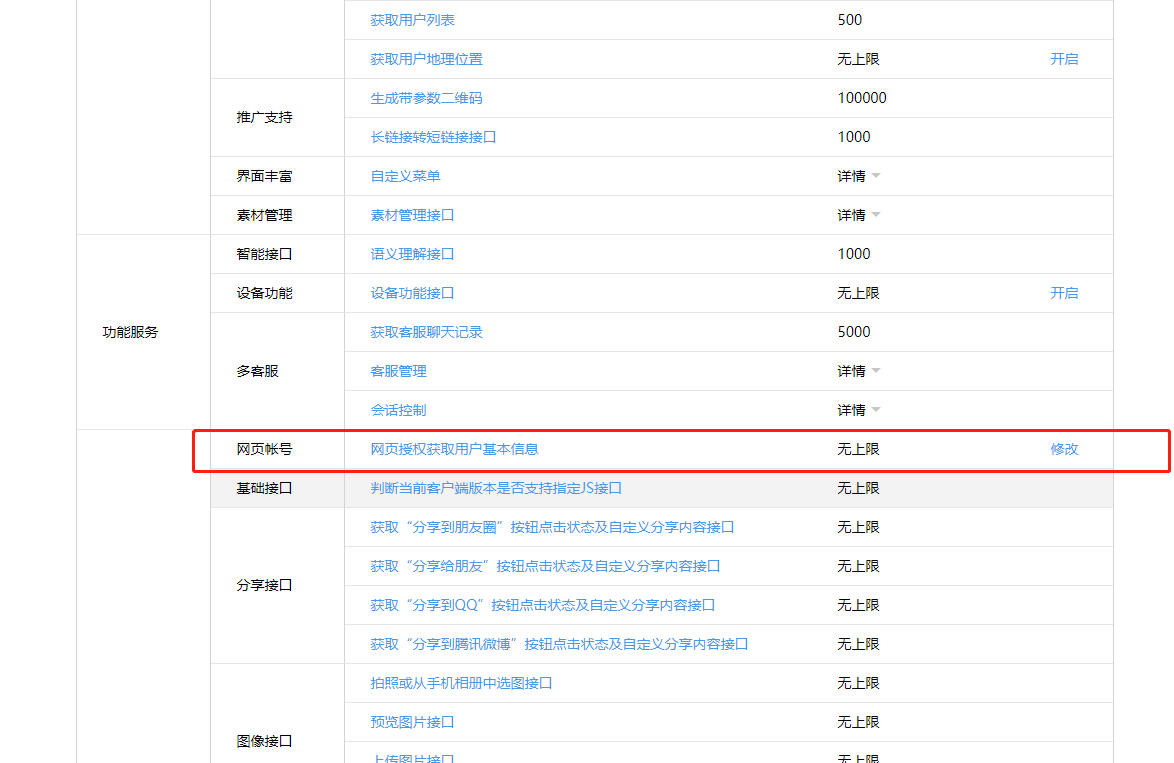一.关于网页授权回调域名的说明
1、在微信公众号请求用户网页授权之前,开发者需要先到公众平台官网中的“开发 - 接口权限 - 网页服务 - 网页帐号 - 网页授权获取用户基本信息”的配置选项中,修改授权回调域名。请注意,这里填写的是域名(是一个字符串),而不是URL,因此请勿加 http:// 等协议头;

2、授权回调域名配置规范为全域名,比如需要网页授权的域名为:www.qq.com,配置以后此域名下面的页面http://www.qq.com/music.html 、 http://www.qq.com/login.html 都可以进行OAuth2.0鉴权。但http://pay.qq.com 、 http://music.qq.com 、 http://qq.com 无法进行OAuth2.0鉴权
3、如果公众号登录授权给了第三方开发者来进行管理,则不必做任何设置,由第三方代替公众号实现网页授权即可
二.具体而言,网页授权流程分为四步:
1 第一步:用户同意授权,获取code
2 第二步:通过code换取网页授权access_token
3 第三步:刷新access_token(如果需要)
4 第四步:拉取用户信息(需scope为 snsapi_userinfo)
5 附:检验授权凭证(access_token)是否有效
第一步:用户同意授权,获取code
在确保微信公众账号拥有授权作用域(scope参数)的权限的前提下(服务号获得高级接口后,默认拥有scope参数中的snsapi_base和snsapi_userinfo),引导关注者打开如下页面:
https://open.weixin.qq.com/connect/oauth2/authorize?appid=APPID&redirect_uri=REDIRECT_URI&response_type=code&scope=SCOPE&state=STATE#wechat_redirect 若提示“该链接无法访问”,请检查参数是否填写错误,是否拥有scope参数对应的授权作用域权限。
尤其注意:由于授权操作安全等级较高,所以在发起授权请求时,微信会对授权链接做正则强匹配校验,如果链接的参数顺序不对,授权页面将无法正常访问
/**
* 用户点击菜单“专业注册”,按照微信规范进行Oauth2授权
* @param request
* @param response
* @param session
* @throws Exception
*/
@RequestMapping("/oauth2/bind")
public void oauth2bind(HttpServletRequest request,HttpServletResponse response,HttpSession session) throws Exception{
String url ="http://ksweixin.free.idcfengye.com/weichat/wx/bind/index";
log.info("进入[专业用户]授权页面,授权url="+url);
//对回调地址编码,防止提交给服务器后乱码
url = URLEncoder.encode(url,"UTF-8");
String redirect = "https://open.weixin.qq.com/connect/oauth2/authorize" +
"?appid=" +appId +
"&redirect_uri=" +url + // 执行回调的地址,由微信服务器去调用
"&response_type=code" +
"&scope=snsapi_base" +
"&state=jgjk" + // 自定义,会传递到上面的url中
"#wechat_redirect";
response.sendRedirect(redirect);
}
用户同意授权后
如果用户同意授权,页面将跳转至 redirect_uri/?code=CODE&state=STATE。
开发文档提到对于以snsapi_base为scope的网页授权,就静默授权的,用户无感知,所以这里不需要用户同意的步骤;
第二步:通过code换取网页授权access_token和openid
首先请注意,这里通过code换取的是一个特殊的网页授权access_token,与基础支持中的access_token(该access_token用于调用其他接口)不同。
公众号可通过下述接口来获取网页授权access_token。如果网页授权的作用域为snsapi_base,则本步骤中获取到网页授权access_token的同时,也获取到了openid,snsapi_base式的网页授权流程即到此为止。
请求方法
获取code后,请求以下链接获取access_token: https://api.weixin.qq.com/sns/oauth2/access_token?appid=APPID&secret=SECRET&code=CODE&grant_type=authorization_code
/**
* 回调方法
* @param request
* @param response
* @param session
* @throws Exception
*/
@RequestMapping("/bind/index")
public String bindindex(
HttpServletRequest request,
HttpServletResponse response,
ModelMap mdmap,
HttpSession session) throws Exception{
// 1.得到授权验证code
String code = request.getParameter("code");
String state = request.getParameter("state");
if(state!=null){
//2.拿到openid
String openid=GetOauthAccessOpenId(code);
log.info("本次拿到openid"+openid);
if(openid!=null) {
Map<String,Object> map = userService.queryWxuserByWxpassport(openid);
mdmap.put("openid", openid);
if(map!=null){ // 已经绑定了,进入解绑页面
mdmap.put("passport", map.get("passport"));
return "unbinding";
}else{ // 还没有绑定,进入绑定页面
return "binding";
}
}
}
return "binding";
}
/**
* <summary>根据Code获取用户的openid、access_token</summary>
* @param code
* @return
*/
public String GetOauthAccessOpenId(String code){
log.info("拿到的code是:" + code);
String url = "https://api.weixin.qq.com/sns/oauth2/access_token?appid=" + appId + "&secret=" + appSecret + "&code=" + code + "&grant_type=authorization_code";
String content =HttpUtil.get(url);
log.info("拿到的url是:" + url);
log.info("获取到的gethtml是" + content);
JSONObject json = JSONObject.fromObject(content);
String Openid = (String) json.get("openid");
return Openid!=null?Openid:null;
}
然后就可以在页面取到openid的值,把这个接口放入菜单的超链接地址,当点击菜单时,就会会获取到openid,下一步就可以根据openid做用户关联绑定等。
<script type="text/javascript"> function my_form_submit(){ var pcpassport = $("#pcpassport").val(); var pwd = $("#pwd").val(); if(pwd==null||pwd==''||pcpassport==null||pcpassport==''){ alert("请先输入完整信息,再提交"); return; } $.ajax({ type: "POST", url: "/weichat/wx/bind", data: {"openid":"${openid}","pcpassport":pcpassport,"pwd":pwd}, success: function (result) { var data = eval("("+result+")"); if(data.errCode==0){ // 绑定用户成功 $(".window_wait").hide(); $(".msg_desc").html("用户绑定成功"); $(".window_msg").show(); }else if(data.errCode==303){ // 303是自定义的一数据 ,不是http 的303 // 解决微信同一个链接发送两次请求的问题 }else{ $(".window_msg").hide(); $(".window_wait").hide(); $(".login").show(); alert("failed:"+data.errMsg); } }, error: function(result) { alert("绑定失败:"+result); } }); } </script>